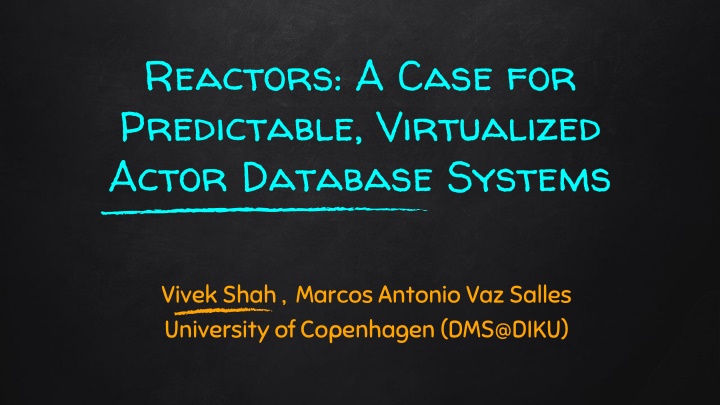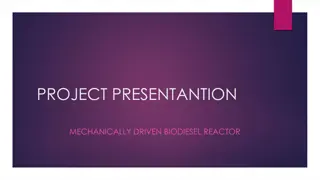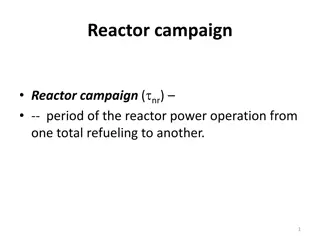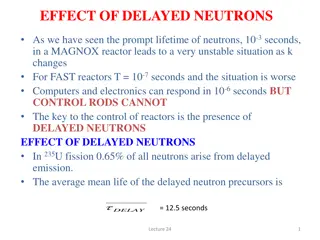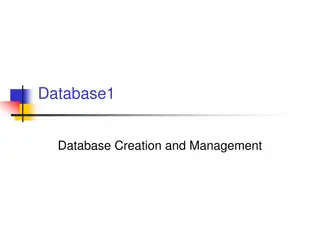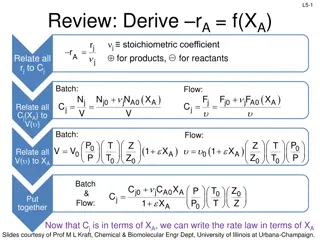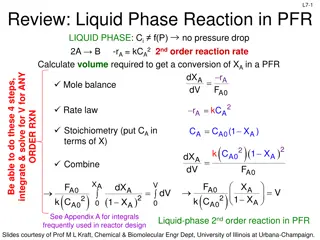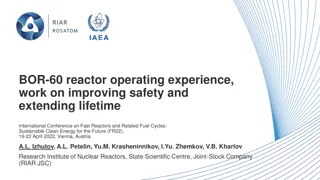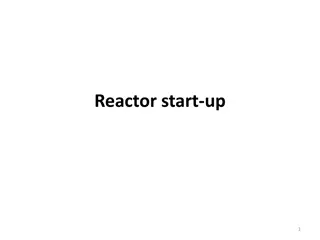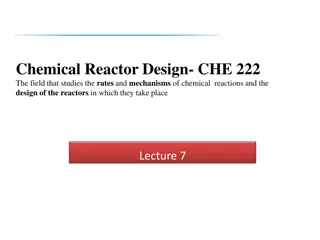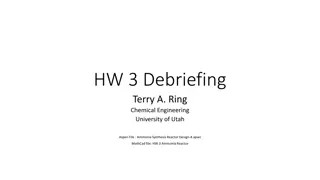Reactor: A Case for Predictable, Virtualized Actor Database Systems
Exploring the integration of actor programming models in modern relational databases to achieve high performance. The focus is on addressing challenges related to stored procedures, data partitioning, modularity, isolation, software engineering, and performance. The talk outlines motivation, the relational actor programming model (Reactor), relational actor database system (ReactDB), and the evaluation process.
Download Presentation

Please find below an Image/Link to download the presentation.
The content on the website is provided AS IS for your information and personal use only. It may not be sold, licensed, or shared on other websites without obtaining consent from the author.If you encounter any issues during the download, it is possible that the publisher has removed the file from their server.
You are allowed to download the files provided on this website for personal or commercial use, subject to the condition that they are used lawfully. All files are the property of their respective owners.
The content on the website is provided AS IS for your information and personal use only. It may not be sold, licensed, or shared on other websites without obtaining consent from the author.
E N D
Presentation Transcript
Reactors: A Case for Predictable, Virtualized Actor Database Systems Vivek Shah , Marcos Antonio Vaz Salles University of Copenhagen (DMS@DIKU)
Increasing NEW oltp application diversity 2
NEW OLTP APPLICATION TRENDS Increasing complexity of application logic Latency is critical Scalability matters 3
optimizing for latency in new oltp applications Application Application Server Server Database Database server server Client Client 4
NEW OLTP DATABASE TO THE RESCUE Modern hardware is fast evolving New OLTP databases are being re-designed to harness their performance Is the programming interface of stored procedures good enough ? 5
When are stored procedures not good enough? Data partitioning not enough Require modularity and isolation Software Engineering Challenges Performance Challenges Leverage locality & intra-procedure parallelism Need abstractions to reason about performance Need low-level control over deployment 6
Actor programming models are desirable Modularity Asynchronicity Concurrency 7
Actor relational databases ?? Actor Runtimes Relational Databases 8
How can we integrate actor programming models in modern relational databases with high performance? 9
Talk outline 1. Motivation / Problem Statement 2. Relational Actor Programming Model (Reactor Reactor) 3. Relational Actor Database System (ReactDB ReactDB) 4. Evaluation 10
2. Relational actor programming model (REACTOR REACTOR) 11
Simplified bitcoin exchange application settlement_risk P_EXPOSURE G_RISK 50000000 23400000 providers NAME RISK TIME WINDOW CBIT_DK 2341569 18-11-17 11:45:67 10 Providers XBIT_US 5909863 18-11-17 11:43:34 30 orders PROVIDER WALLET VALUE SETTLED Wallets CBIT_DK 43 450 N XBIT_US 42 1000 Y XBIT_US 85 356.23 N 12
What is a Reactor? A reactor is an application-defined actor encapsulating state as relations Concurrent (Single-threaded) Isolated Reactor Type Schema + Methods Reactor Instance Type + Unique name assigned by the programmer 13
Examples of reactor types and instances reactor Provider { Relation orders { wallet int, value float, settled char(1) } reactor Exchange { Relation settlement_risk { p_exposure float, g_risk float }; Relation provider_names { value varchar(32) }; Relation provider_info { risk float, time timestamp, window interval }; void auth_pay(pprovider, pwallet, pvalue) { ... } float sim_risk(exposure) { } } float calc_risk(p_exposure){ } void add_entry(wallet, value){ } Name: XBIT_US Name: CBIT_DK Name: OneEx } 14
Declarative queries within a reactor Declarative queries to access isolated relational state within a reactor Relational Key/Value Require modularity and isolation Hybrid
Declarative queries within a reactor reactor Provider { Relation orders { wallet int, value float, settled char(1) }; Relation provider_info { risk float, time timestamp, window interval }; float calc_risk(p_exposure){ SELECT SUM(value) INTO exposure FROM orders WHERE settled = 'N'; if exposure > p_exposure then abort; SELECT risk, time, window INTO p_risk, p_time, p_window FROM provider_info; if p_time < now() - p_window then p_risk := sim_risk(exposure); UPDATE provider_info SET risk = p_risk, time = now(); end if; return p_risk; Exposure of a provider within threshold, risk simulated } void add_entry(wallet, value){ INSERT INTO orders VALUES (wallet, value, N ); } 16 }
Communication with reactors Leverage locality & intra-procedure parallelism Communication across reactors using asynchronous function calls Need abstractions to reason about performance by specifying reactor names Async method invocation Future result Invocation:- fut_res := fn(params) on reactor_name; Require modularity and isolation Synchronization:- fut_res.get(); 17
Communication with reactors reactor Exchange { Relation settlement_risk { p_exposure float, g_risk float }; Relation provider_names { value varchar(32) }; void auth_pay(pprovider, pwallet, pvalue) { SELECT g_risk, p_exposure INTO risk,exposure FROM settlement_risk; results := []; foreach p_provider in (SELECT value FROM provider_names) { res := calc_risk(exposure) on reactor p_provider; results.add(res); } total_risk := 0; foreach res in results total_risk := total_risk + res.get(); Total simulated risk across providers within threshold if total_risk + pvalue < risk then add_entry(pwallet, pvalue) on reactor pprovider; else abort; end if; } } 18
Automatic synchronization with reactors Method invocation on the same reactor are Client synchronous despite the asynchronous A communication model. B C D Parent method completes only when its E F G children methods finish 19
Reactors provide transactional guarantees All-or-nothing atomicity Durability A B A B Serializability guarantees Unsafe program executions are aborted Formalized equivalence to classical transactional model A B C D 20
3. In-memory actor relational database system (ReactDB) 21
In-memory database architecture design problem .. Reactors Multi-core machine with large main memory How do we map a set of reactors to the compute and memory resources of a large multi-core machine? 22
Delegate to operating system abstractions Each reactor is a process vs each reactor is a thread Lack of scheduling flexibility and control Overheads 23
ReactDB architecture building blocks Transaction Executors Abstracts a physical core Containers Abstracts a set of physical cores and the memory shared by them 24
How do we map a set of reactors to the compute and memory resources of a large multi-core machine? Map reactors to transaction executors (many to many) such that a reactor belongs to one container only Map transaction executors to containers (many to one) Need low-level control over deployment Specified manually at deployment time 25
Multi-core machine Container Container Transaction Executor Transaction Executor ReactDB Architecture Container Request Queue Request Queue Transaction Coordinator Transport Driver Container Transaction Router 26
ReactDB deployments Container Container Transaction Executor (A,B) Transaction Executor (C,D) Simple Router Simple Router shared-nothing 27
ReactDB deployments Container Container Transaction Executor (A,B) Transaction Executor (C,D) Transaction Executor (A,B,C,D) Transaction Executor (A,B,C,D) Affinity based Router Load Balancing Router shared-everything-with-affinity shared-everything -without-affinity Hybrid deployments possible, not explored in this work 28
ReactDB implementation overview Thread Management in Transaction Executors Threadpool uses cooperative multitasking Minimize context switches Configurable multi-programming level Maximize resource utilization 29
ReactDB implementation overview Concurrency Control Single Container OCC protocol (Silo, [Tu et al. 2013]) Synchronous execution to leverage shared memory Multi-Container OCC + 2PC protocol Asynchronous execution across containers Storage Layer Relations of all reactors in a container stored as primary indices (Masstree [Mao et al. 2012]) in memory Durability not implemented yet 30
4. Evaluation of Reactors and ReactDB 31
Can we really leverage asynchronicity for performance gains in new oltp using reactors and ReactDB ? 32
Experimental setup Workload : Bitcoin exchange auth_pay program Deployments shared-everything-with-affinity container -> sequential shared-nothing containers Parallel exposure calculation followed by sequential risk calculation -> query-parallelism Fully parallel exposure and risk calculation (as shown in example code before) -> procedure-parallelism 33
Experimental setup Machine with 2X AMD Opteron 6274 with 8 cores@2.1 GHz, L1i 64 KB, L2 2MB, L3 shared 6 MB, 125 GB RAM, 64 bit Linux 4.1.15 1x Exchange reactor, 15X Provider reactors (30,000 orders per of which 800 latest orders used for exposure calculation) Varying complexity of sim_riskby random number generation Single worker to generate the workload 34
Asynchronicity gains manifest with increasing parallelizable application logic 35
What about the effect of load on gains from asynchronicity ? Can db architecture virtualization help ? 36
Experimental setup Machine Setup Machine with 2X AMD Opteron 6274 with 8 cores@2.1 GHz, L1i 64 KB, L2 2 MB, L3 shared 6MB, 125 GB RAM, 64 bit Linux 4.1.15 Workload 100% TPC-C new-order augmented with artificial delay of 300 - 400 ?sec to simulate stock replenishment analytics per warehouse Implemented by modeling a warehouse as a reactor Deployment shared-nothingvs shared-everything-with-affinity Scale factor of 8, varying workers to simulate load on the database 37
asynchronicity gains offset by queuing shared-nothing deployment best at low load cross over happens much earlier without delay @2 workers Asynchronicity gains diminish with increasing load 38
Conclusion NEW OLTP + modern databases -> Needs rethink of the existing stored procedure programming model Reactor programming model marries actor programming construct with relational data model and querying ReactDB leverages the Reactor programming model and a containerization mechanism to allow control of database architecture at deployment time thanks! Poster session tomorrow at 16:00 40
thanks! Any questions? You can find me at http://www.diku.dk/~bonii @bonivivek bonii@di.ku.dk 41
